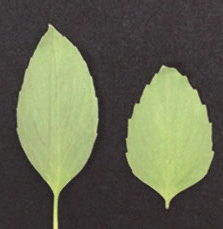Evaluation of Morphological Traits, Dowdy Mildew Tolerance and Phytochemical Contents of Sweet Basil Germplasm Collected by Tropical Vegetable Research Center, Kasetsart University in Rainy Season
Keywords:
selection, downy mildew, morphology, phytochemicalAbstract
Sweet basil is an important vegetable as domestic consumption and export due to high nutrition and medicinal properties. There is not much an information in breeding program and less diversity in sweet basil. Another problem of sweet basil is susceptible to downy mildew, especially in a rainy season. Therefore, the objective of this study was evaluation of sweet basil germplasm collected by Tropical Vegetable Research Center, Kasetsart University by investigating their morphological characteristics, tolerance to downy mildew in the rainy season and phytochemical content. Fifty three accessions were evaluated in leaf shape, leaf length, leaf width, inflorescence type, corolla color and phytochemical contents such as beta-carotene, chlorophyll A and chlorophyll B. The results showed that there were 10 accessions of sweet basil germplasm those were resistant to downy mildew. They were OC015, OC142, OC145, OC145-A, OC145-C, OC145-D, OC153, OC159, OC161 and OC161-A. Most of the leaf characteristics were ovate shape, serrate leaf margin, medium leaf margin depth and leaf length was between 4.1 and 6.8 cm, leaf width was ranging from 2.0-3.1 cm. There were 2 types of inflorescence characteristics that were group inflorescences (8 accessions) and verticillate cyme (40 accessions). Additionally, there were 5 accessions those had both inflorescence characters. The beta-carotene, chlorophyll A and chlorophyll B contents of resistant germplasm were 2.322-3.047, 8.408-11.564 and 2.588-3.819 mg/100 g FW, respectively. There were 13 selected sweet basil accessions those recovered from downy mildew and were grown in greenhouse and outside greenhouse conditions. The beta-carotene content of those were ranging from 1.814-2.253 mg/100 g FW. Furthermore, there were 2 selected accessions (OC058 and OC071) those could be grown in both greenhouse and outside greenhouse conditions, with no differences in beta-carotene, chlorophyll A and chlorophyll B contents.
References
กรมวิชาการเกษตร. 2553. การตรวจพบสารพิษตกค้างและเชื้อจุลินทรีย์ปนเปื้อนไปในในผลผลิตผักสดหลายชนิด. (ระบบออนไลน์). แหล่งข้อมูล :http://www.doa.go.th/psco/images/Law/six teen%20plants%20in%20the%20el.pdf (13 ตุลาคม 2561)
คัทลียา ฉัตร์เที่ยง. 2542. การศึกษาลักษณะทางสัณฐานวิทยาและการสร้างผลผลิตของพืชสกุลโหระพา 4 ชนิด. ปัญหาพิเศษปริญญาตรี. มหาวิทยาลัยเกษตรศาสตร์ วิทยาเขตกำแพงแสน, นครปฐม. 15 หน้า.
ธนิกพงศ์ ครองข้าวนาสาร. 2555. การวิเคราะห์ปริมาณวิตามินซี คลอโรฟิลล์ และเส้นใยอาหารของต้นทานตะวันงอก. ปัญหาพิเศษปริญญาตรี. มหาวิทยาลัยเกษตรศาสตร์ วิทยาเขตกำแพงแสน, นครปฐม. 19 หน้า.
ปณิตา ประสงค์ดี. 2558. การสกัดและฤกธิ์ทางชีวภาพของโหระพาไทย. วิทยานิพนธ์วิทยาศาสตรมหาบัณฑิต, มหาวิทยาลัยเทคโนโลยีสุรนารี, นครราชสีมา. 132 หน้า.
ปวีณ์นุช เลขะพันธุ์, เกษรา อนามธวัช-จอนสัน และเพลินพิศ โชคชัยชำนาญกิจ. 2560. ความหลากหลายของพฤติกรรมของโครโมโซมในการแบ่งเซลล์แบบไมโอซิสของโหระพา (Ocimum basilicum L.) ในประเทศไทย.วารสารวิทยาศาสตร์ มศว. 33(2): 35-50.
วรพล ลากุล. 2558. การศึกษาลักษณะทางปริมาณของสารเบต้าแคโรทีนในประชากรรุ่น F2 ของฟักทองลูกผสมระหว่างพันธุ์บึงกาฬ พันธุ์ชัยพฤกษ์และพันธุ์ Early-Price. ปัญหาพิเศษปริญญาตรี. มหาวิทยาลัยเกษตรศาสตร์
วิทยาเขตกำแพงแสน, นครปฐม. 21 หน้า.
วิลาสินี รามนัฏ. 2545. การศึกษาลักษณะเชื้อพันธุ์พืชสกุลโหระพา. ปัญหาพิเศษวิทยาศาสตรมหาบัณฑิต. มหาวิทยาลัยเกษตรศาสตร์ วิทยาเขตกำแพงแสน, นครปฐม. 31 หน้า.
ศิริพร ตันติโพธิ์พิพัฒน์. 2557. คุณค่าทางโภชนาการและสมบัติเชิงสุขภาพของผักพื้นบ้านไทย. 23-28 หน้า. ใน รายงานประชุมวิชาการแห่งชาติด้านอาหารและโภชนาการเพื่อสุขภาพ ครั้งที่ 1. สถาบันโภชนาการ มหาวิทยาลัยมหิดล และภาคีเครือข่ายด้านอาหารและโภชนาการ. กรุงเทพฯ.
อรพรรณ วิเศษสังข์. 2560ก. โรคโหระพาที่พบการระบาดช่วงอากาศเย็น. วารสารเคหการเกษตร. 41(3): 167-170.
อรพรรณ วิเศษสังข์. 2560ข. โรคเหี่ยวของโหระพา. วารสารเคหการเกษตร. 41(4): 171-174.
Filip, S. 2017. Basil (Ocimum basilicum L.) a source of valuable phytonutrients. Int. J. Clin. Nutr. Diet.
: 118.
Nagata, M. and I. Yamashita. 1992. Simple method for simultaneous determination of chlorophyll and carotenoids in tomato fruit. J. Japan Soc. Food Sci. Technol. 39: 925-928.
Sanni, S., P.A. Onyeyili and F.S. Sanni. 2008. Phytochemical analysis, elemental determination and some in vitro antibacterial activity of Ocimum basilicum L. leaf extracts. Res. J. Phytochem. 2: 77-83.





